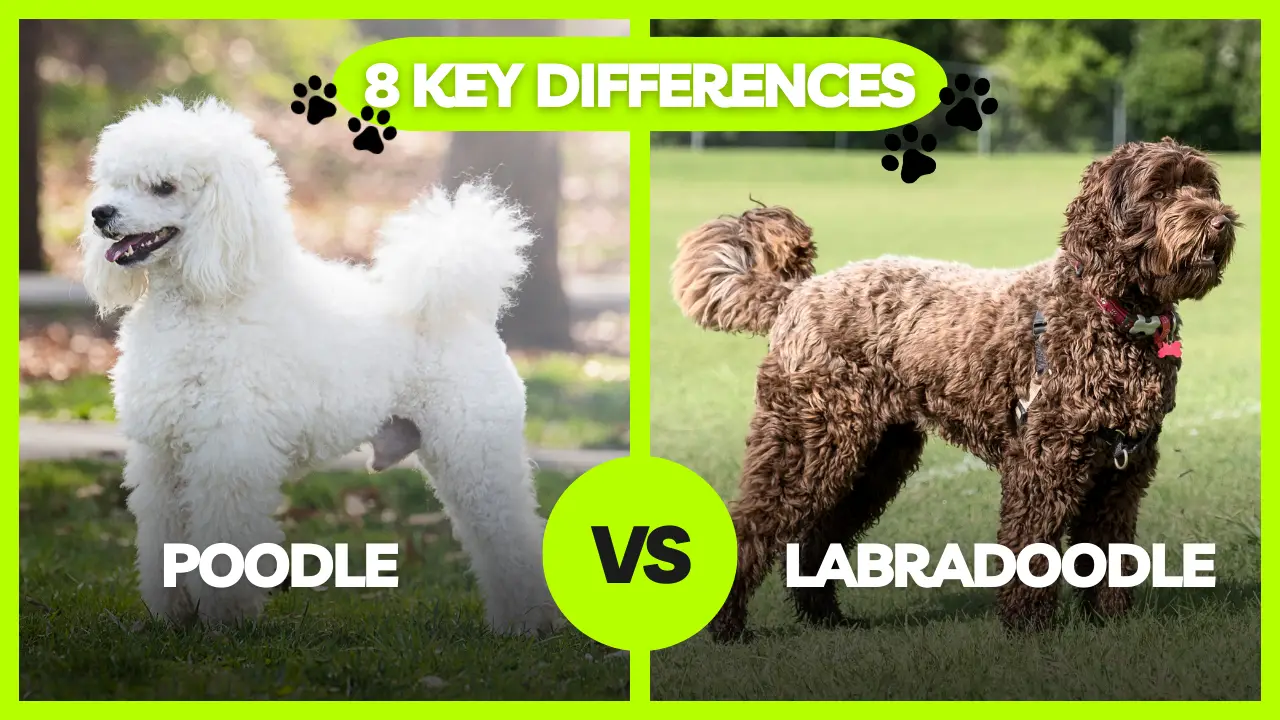If you’re considering getting a poodle or labradoodle, you may be wondering what the difference is between the two breeds. Both are popular choices for families with allergies, but there are a few key distinctions to be aware of. In this post, we’ll take a comprehensive look at both breeds – from coat types and shedding to temperaments and trainability. By the end, you should have a good idea of which breed is right for your home.

| Poodle | Labradoodle | |
| Weight | 40-80 pounds (18-36 kg) | 50-60 pounds (22-27 kg) |
| Height | 10-22 inches (25-55 cm) | 21-24 inchs (53-60 cm) |
| Life Expectancy | 10 to 15 years | 12 to 16 years |
| Average Price | $1,200 | $1,000 |
What Will You Learn? 👇
Poodle vs. Labradoodle Appearance
Poodles come in multiple sizes, from Standard Poodles large enough to act as hunting dogs or small enough to fit into a large teacup. The American Kennel Association (AKC) has three recognized Poodle sizes. These sizes are Standard, Miniature, and Toy Poodles. They can range from a couple of pounds up to 80 pounds in weight and stand anywhere from 10 to 22 inches tall.
Unlike many dogs, Poodles have a silky hair coat instead of fur. This means that they are hypoallergenic and shed less than other breeds.

Read our Smart Poodles - Smart Tricks eBook for only $2.99
Dive into a treasure trove of engaging tricks and tips designed specifically for your poodle!
Poodles come in various signature colors, including white, cream, silver, gray, café-au-lait, russet, blue, and brown.
With a thicker body and unique curly or wavy wool, fur, or hair coat, Labradoodles are all the popular rage. Labradoodles are not an official breed, because they are a hybrid. This means that they don’t have papers from the AKC, and you can’t be sure that they have health screenings.
🐩 I've also covered Poodles vs Goldendoodles, so make sure you check that article as well.
They are also considered large breed dogs weighing in at an average of 50 to 60 pounds. They also stand taller than Poodles at 22 to 24 inches high. They have a lovely assortment of coat colors: blonde, apricot, chocolate, and brown.
Labradoodle vs Poodle Temperament and Personality
Poodles are a type of dog that is easy to get along with. They are smart and energetic, which makes them great companions. They also learn tricks and tasks quickly. A purebred Poodle has a more regal temperament and an aloof, aristocratic air than a crossbred Labradoodle. They are sometimes shy and peaceful dogs.
Poodles can live in different types of places like apartments, ranches, or the suburbs. They are good at showing off their skills in dog championships or obedience trails.

With a Labradoodle’s temperament, you get the best of both worlds. From its Labrador Retriever parent breed, a Labradoodle gets its good nature, and from its Poodle parent it gets its high intelligence.
They are incredibly affectionate and love being with adults, children, and other dogs. While they need even more exercise than a Poodle, a Labradoodle isn’t quite as needy as a purebred Poodle.
This is one dog that is a super cuddler and a lovable goofball that hates being left alone too much. They also have a less dignified air than a Poodle and are more apt to bark and act protective with strangers.
Dogs need a regular exercise routine. This helps them burn off energy that can make them act anxious or destructive. For Poodles and Labradoodles, it’s important to find an owner who can stick to a routine. They can live anywhere as long as their exercise and mental stimulation needs are met.
Poodle vs. Labradoodle Training
Super smart and eager to please, Poodles and Labradoodles are easy to train. Both dogs have razor-sharp intelligence and a social personality that makes them want to bond with and learn from their owners.
You’ll want to start training the puppy as soon as possible. Poodles are very intelligent animals and can be stubborn if they’re not trained properly when they’re young.
Athletic and alert, Poodles enjoy training sessions and learning new things. Poodles are companionable dogs that prefer to be with people. This makes them more willing to train than other breeds of dogs that may be less social. Mix up their routine and let them learn new tricks since they are easily bored and enjoy various mental and physical activities.
Poodles also dislike being cooped up and alone, so getting them properly crate-trained may take more work. Getting the right size dog crate that’s big enough can help your dog avoid feeling claustrophobic.
Similarly, Labradoodles may inherit strong traits from both their Poodle and Labrador parents. If a Labradoodle is not trained properly and is neglected, it might be harder to train when they get older. In addition, since Labradoodles are intensely energetic, they can develop bad habits and behavior that will be hard to break later on.
With a bouncy and friendly nature, a Labradoodle gets along well with people and other dogs. Labradoodles want to be friendly with everyone they meet, so it’s important to train them on how to behave around humans. This will help them stay safe and make good impressions on people.
Labradoodles need to socialize with other dogs. This will help them develop good social skills. You can do this by taking your puppy for walks with friends or going to a dog park. skills.
Poodle vs. Labradoodle Life Expectancy
With good care, a Poodle can live anywhere from 10 to 15 years, while a Labradoodle’s life expectancy ranges from 12 to 16 years. Due to their hybrid hardiness, Labradoodles are considered the healthier of the two dogs. The better breeding a dog has, the longer you can expect them to live.
It’s wise to take your dog to the vet for regular health checkups to catch and treat any problems early. That way, your pet can expect to live a longer, healthier life.
Poodle and Labradoodle Exercise
These dogs are perfect for an active, outdoor lifestyle since they require plenty of exercises. They aren’t the type of dog that is happy lounging around an apartment. They also need more exercise than other dog breeds.

Even though Poodles can live in an apartment, their athletic instincts are still intact from their hunting ancestors. They love swimming and retrieve better than American retrievers due to their high intelligence and light build. A Standard Poodle will need more exercise and excel at various athletic activities more than a Toy Poodle.
Since Poodles are calmer than Labradoodles, playing fetch or going for a walk at the park will help keep them healthy and happy.
On the other hand, Labradoodles need a house with a yard to romp in since they have high energy levels. So you’ll want to incorporate plenty of games and half an hour to an hour of exercise for Poodles or Labradoodles daily.
A dog that’s cooped up in the house all day without much to do will develop a kind of canine cabin fever. Without a way to release their pent-up energy, your dog can get frustrated and start to act out. If you notice your dog pacing, tearing up objects, or destroying furniture, it’s time to head out for an exercise session.
Another good way to make sure your dog is getting enough stimulation is to give them toys that help keep their brain active. This will help keep them from getting bored and destructive. Regular exercise and mental engagement will give both dog breeds a healthy way to release tension and help them know what to expect from their day.
Poodle vs Labradoodle Health Problems
The best way to ensure good health for your Poodle or Labradoodle is to do your research first and only buy from a responsible source. That’s because respected breeders spend time and money screening for genetic diseases or health issues in individual puppies. Unfortunately, unethical breeding tend to skip these kinds of tests.

If a dog is bred too extensively, this can result in health issues or a dog that is falling apart at the seams. Therefore, it’s best to be wary of super great deals when it comes to Poodle prices, since it’s probably too good to be true and can mean that a dog is in-bred and ripe for a host of health problems.
With Labradoodles, they check a dog’s health and genetics. At the same time, Labradoodles have hybrid health and vigor which makes them less disposed to some of the same health issues that can plague a Poodle.
Poodle Health
While these dogs live a long time on average, they also tend to have hormone diseases like Addison’s Disease and Cushing’s Disease, which impact a dog’s adrenal and cortisol glands. A Poodle suffering from these diseases can make them more anxious and set their fight or flight instincts on high alert.
Poodles also are susceptible to joint problems that affect the hips and kneecap (patella). You’re also more likely to see skin disorders like sebaceous adenitis that causes dry skin and patchy hair. Up to 50% of Standard Poodles either have it or carry faulty genes that can cause the disorder.
Labradoodle Health
Labradoodles are considered the healthier of the two dog breeds. This doesn’t mean that the Labradoodle is free from health problems, however.
Labradoodles are prone to ear infections. To help prevent these, you can check their ears and clip any stray hairs. They can also suffer from the following:
- hypothyroidism,
- diabetes mellitus,
- elbow and hip dysplasia,
- epilepsy,
- progressive retinal atrophy,
- Addison’s Disease,
- hypoglycemia,
- collapsed trachea,
- allergies,
- bloat.
They can also inherit a tendency towards adrenal gland issues from their Poodle parent.
Both kinds of dogs can experience thyroid problems and hip dysplasia. It’s important to make sure your dog gets enough exercise. This will help keep them healthy and avoid joint problems. Try to avoid going on walks that are too long or too frequent, as this can be hard on their joints.
It’s also wise to feed your high-quality dog food that’s easy on their sensitive stomachs. This will ensure that your Poodle or Labradoodle lives the healthiest life possible.
Poodle versus Labradoodle Grooming
Labradoodles and Poodles both need grooming, but the type of grooming needed depends on the type of coat the dog has. Poodles need more intense grooming because they have a short, curly coat. Labradoodles’ coats can be either wool, fleece, or hair, so they only need average grooming.
Poodles need regular baths, every 2-3 weeks, and routine brushing and trimming to keep their hair from matting and shedding. Aim to brush your Poodle’s coat on regular basis. A pair of trimmers can help you keep your dog’s coat tidy at home without booking a session at a professional groomer every 6 to 8 weeks.
Clip toenails regularly. Check your Poodle’s low-hanging ears for any stray hairs that can cause infection. You’ll also want to take your Poodle for dental checks to ensure oral health regularly. The same grooming and oral hygiene needs goes for the Labradoodle.
The good news is that Poodles are both hypoallergenic and less prone to shedding. Labradoodles don’t need as much grooming as other breeds of dogs, but you’ll have to vacuum more often because they shed their coats twice a year. Many owners only clip their Labradoodles 2 to 4 times every year.
It is OK to bathe your Labradoodle every 4 to 5 weeks. Yet, you might need to give your dog more frequent baths during the time of year when they shed or when they are in heat (for females).
Labradoodles bred from second, third, or fourth-generation Labradoodles are less likely to shed. This is because the bloodline is more distant from its Labrador parent. But, at the same time, this isn’t guaranteed since genetics are a tricky thing, you can end up with a dog that sheds just as much as its Labrador ancestor.
There are special shampoos for dogs with sensitive skin. They are often organic and hypoallergenic. This will help keep your dog’s coat smelling fresh and healthy.
Poodles and Labradoodles Puppy Prices
Both these dogs fetch a high price, the Poodle because it is a purebred dog with show capabilities and the Labradoodle because it is a designer dog. When you buy a dog, it is important to make sure that you get one from a responsible breeder. This is someone who will ensure the pedigree and health of the dog. They will also be more expensive.
You can expect to pay at least $1,000 for a Poodle or Labradoodle puppy. For a purebred Poodle with excellent ancestry, you might pay anywhere from $1,200 upwards for a top-quality dog.
Labradoodles are not an official breed, so they are not subject to AKC requirements. This means that you can still buy good dog from a respected breeder at a lower price. Keep in mind that you won’t get papers for a Labradoodle since they aren’t an actual breed.
Labradoodle puppies with an excellent heritage from a quality breeder can cost between $1,000 and $3,000. This price can vary depending on the background of the puppy, the location, and the breed’s popularity.g desirability.
If you’re going for a championship Poodle with blue bloodlines, this will land you in at the higher end of the price range.
If you’re going for a normal family pet, this will put you more in the $1,200-$1,500 price range. It’s also a good idea to get any dog screened for health and genetics before bringing your puppy home.
Marko is the founder and author at PoodleHQ, where he blends profound expertise with formal training in Animal Behavior and Canine Genetics. With multiple generations of poodles under his care, he’s a breed connoisseur, honored with the Canine Care Excellence Award and lauded by the International Pet Enthusiasts Association.

